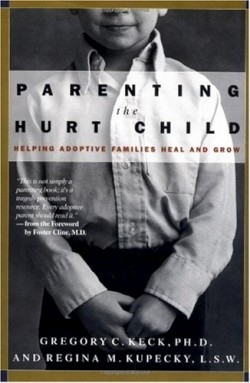It looks like you've stumbled upon a page meant to be read by our code instead of viewed directly. You're probably looking for this page.
Parenting the Hurt Child
Helping Adoptive Families Heal and Grow
Children who have been abused or neglected aren’t like other boys and girls—and even the most loving adoptive parents will fail if they treat them like kids from normal, nurturing homes, say the authors.
Keck and Kupecky point out that many adopted children have gone through serious trauma that retards their emotional development and cripples their ability to bond with their new parents. The book devotes some attention to explaining the causes and results of childhood trauma, but its real focus is on giving parents tools for reaching through the hurt, fear, and anger to connect with an adopted child.
In one example, a mother starts giving her fourteen-year-old adoptive daughter, a girl raised in a crack house until the age of five, “baby time.” Each day the girl would sit in a crib made of pillows and scarves, playing with baby toys, to make up for what she missed as an infant. Fortunately, not all of the book’s suggestions stretch the bounds of normal parenting quite so far. They include simple gestures like heating up a child’s gloves in the dryer on a cold day or sharing a lap robe while watching television.
At the same time, the authors caution that traditional parenting methods, such as giving “time outs,” can backfire. “Children who have had so much loneliness and separation from their birth parents need to be with their new parents,” they write. “Quite simply, they need time ins.”
This book is a sequel to the 1995 volume by Keck and Kupecky, Adopting the Hurt Child. Like the first book, it draws heavily on the authors’ clinical experience with adoptive families. Keck, a psychotherapist, is founder of the Attachment and Bonding Center of Ohio. Kupecky is a therapist at the center and has worked in adoption placement for twenty-five years.
The authors are refreshingly unsentimental in their attitude toward adopted children. Though they insist that these children deserve all the care a parent can give, they also recognize that a hurt child can be belligerent, infuriating, and even dangerous.
The authors take an equally evenhanded approach to parents, refusing to blame or coddle them. “We want to make it clear that foster and adoptive parents are not responsible for the development of their children’s problems,” they write. “But they are responsible for creating the proper environment for change.”
In other words—it’s a tough job, but the parents volunteered, so if they want to do it right, this book will help. For parents immersed in the often frustrating and painful task of bonding with a hurt child, that may be the most important message they ever hear.
Reviewed by
Karen Holt
Disclosure: This article is not an endorsement, but a review. The publisher of this book provided free copies of the book to have their book reviewed by a professional reviewer. No fee was paid by the publisher for this review. Foreword Reviews only recommends books that we love. Foreword Magazine, Inc. is disclosing this in accordance with the Federal Trade Commission’s 16 CFR, Part 255.
